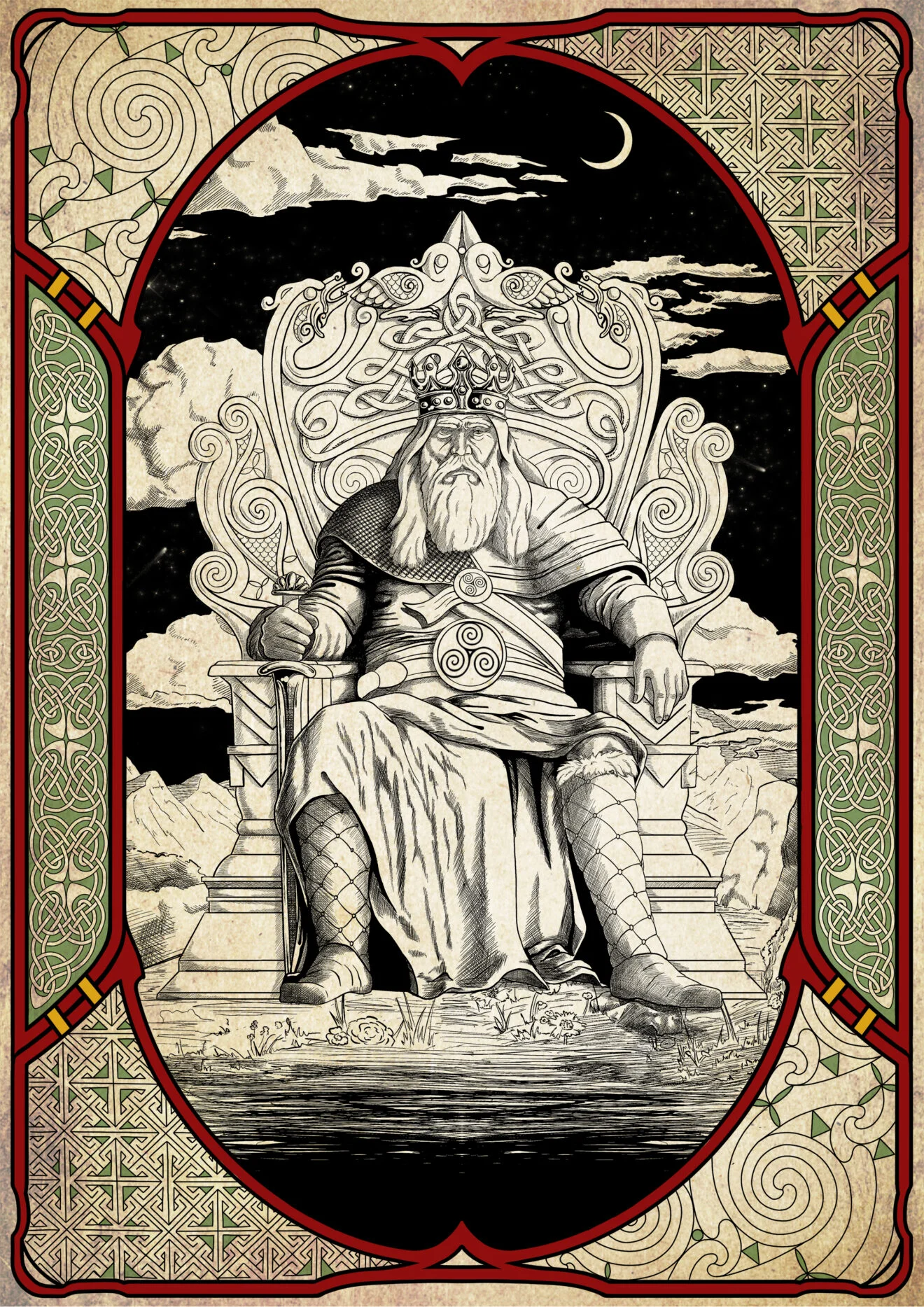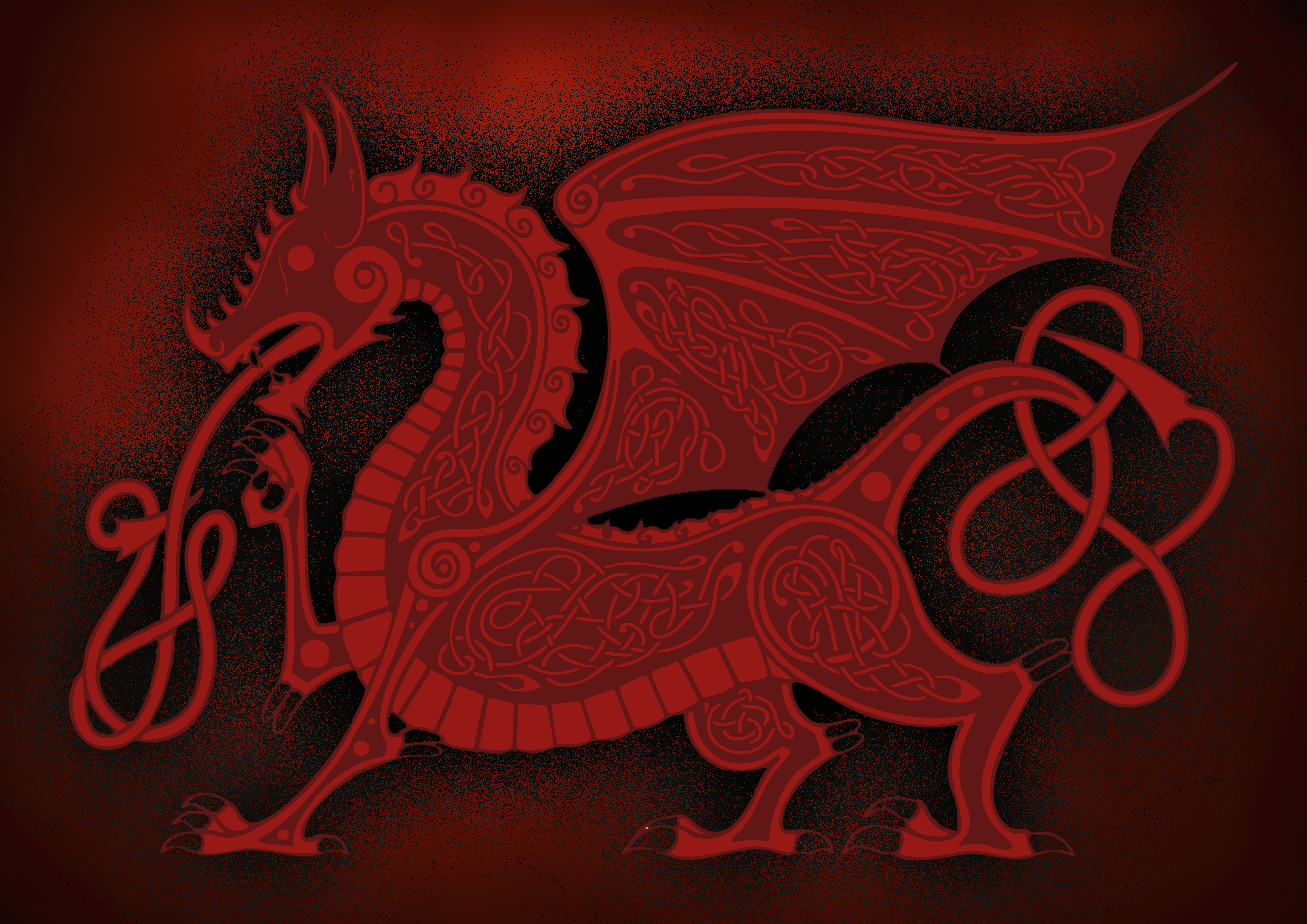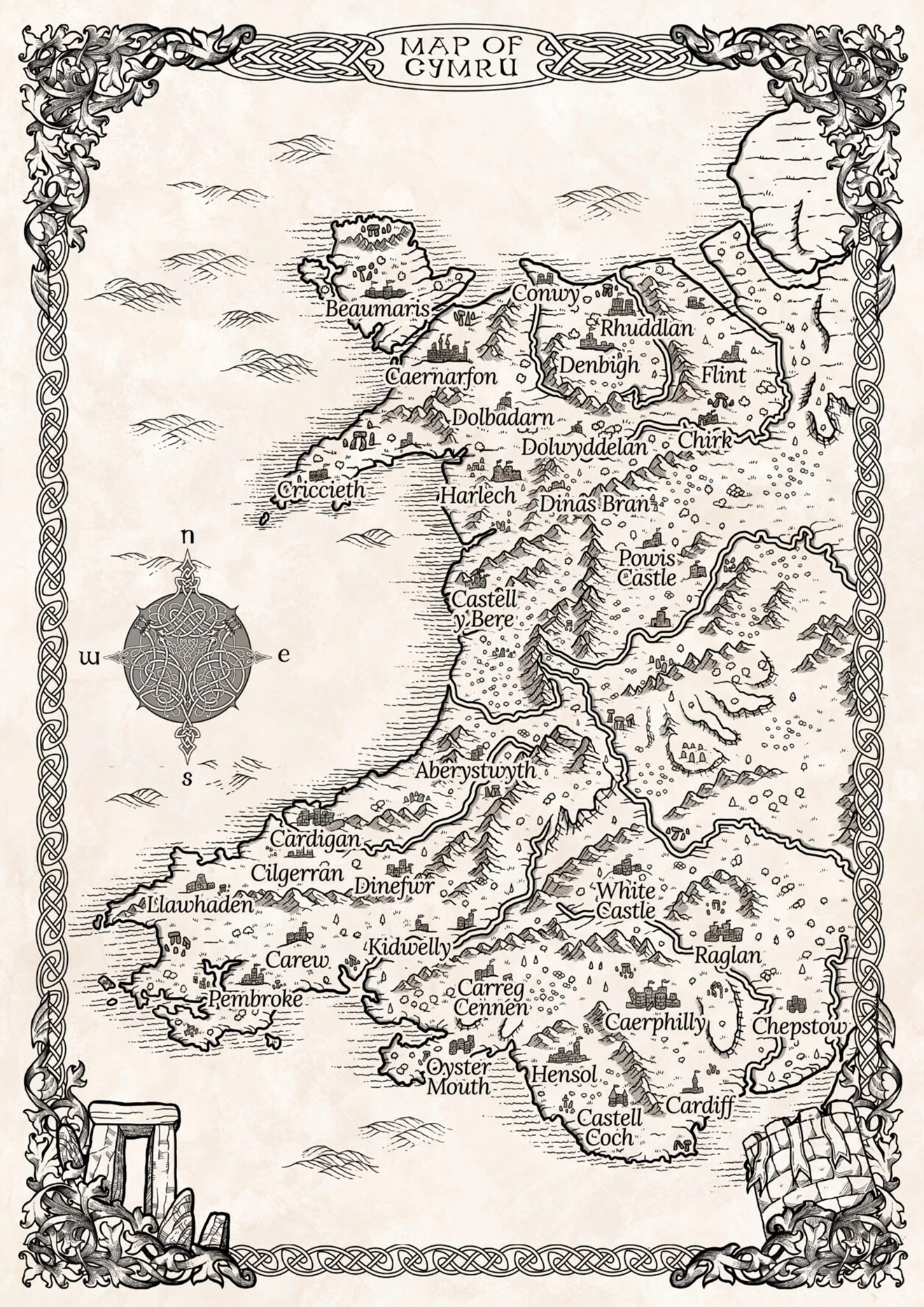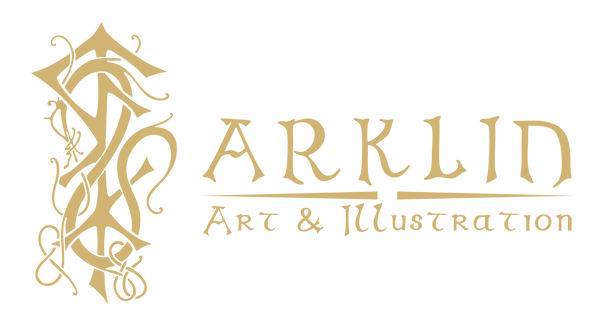
WOAD: STONE TO STONE
Forge your own path through Mythic Cymru: a beautiful custom tarot deck is your guide to Welsh mythology in this solo journalling game.
In WOAD, a beautiful custom Tarot deck is your guide through a journey inspired by Welsh mythology.
You’ll travel from standing stone to standing stone, capturing your quest in your journal as you encounter friend, foe, and fae. Gods will bless and curse you; long nights will try to end you. And, if your story survives to be heard by the next generation, you may even become part of the myth yourself.

This game began as an idea to help spread some of the lesser known aspects of Welsh mythology.
I’ve lived in Wales for 12 years (over a third of my life) – from this, and from studying mythology at a Welsh university, I realised how little I truly knew about the rich and wonderful mythology of the land I now call my home.
Having played numerous journaling RPGs, one of my biggest goals with WOAD was to create something more involved for the player. Rather than rolling a dice or drawing a card before referring to a table, I wanted to create something that felt more like a game – something with more mechanical elements to strengthen the story you’ll tell in your journal. Thus the idea of a custom Tarot deck was born: a full set of major and minor arcana cards containing all the threads you’ll need to weave your story’s tapestry. (Not to mention beautiful original illustrations.)
This unique but simple gaming system steers you on your journey through mythic Cymru, resolving connecting story prompts for better or worse whilst incorporating the boons and banes of the Gods of the Major Arcana.

To find the Red Dragon. This is your purpose, your driving force through your story.
It sounds simple, and it is, but the beauty of it is that it’s yours to interpret. What will your Red Dragon be?
Oh, yes, it could mean the fabled Dewi, buried under hill and cloth by Lludd, endlessly battling the white dragon. Perhaps it is your fate to release him and cleanse the land of the Anglo-Saxon invaders. Or maybe the Red Dragon is a symbol, a banner of a resistance building in the hidden valleys of Cymru. Could it be the future king? Perhaps a powerful weapon, the fire of enlightenment, or even the power to bend flame to your will?
This story is yours to tell; we simply give you a path to walk, a journey to unfold, as you tell it.
WOAD puts you in control of driving your own story, even changing it. Perhaps you find that what you originally sought was not what you hoped.


When you back WOAD, you’re getting 78 fully custom, gorgeously illustrated cards to play with. (And 56 of them are double-sided, so… it’s really more like a total of 134 cards.)
Each turn represents one day of your journey through the world of WOAD. You’ll draw cards depicting events along your travels and arrange them into a day of adventure, before flipping the cards to reveal the connecting night-time prompts. Can you overcome every obstacle? Your only help is the blessing of near-forgotten gods and the memory of long-dead heroes, so survival in this harsh land won’t be easy.
Your journal captures your quest as you travel, chronicling your victories and leaving a record for future generations. The kind of legend you become may be more important than you think.
Using the beautifully drawn map by Fernando Salvaterra (@salvaterra), you can mark your progress using the standing stones to link where you travel to. In a day you can travel between adjacent stones or castles to create a consistent journey through Mythic Cymru!

Pictured above: The Map of Cymru ^

When you back WOAD, you’re getting 78 fully custom, gorgeously illustrated cards to play with. 56 of them are double-sided.
The game is set around 1100AD with King William II on the throne of England (LLoegyr) and Prince Gruffudd ap Cynan just risen to the throne of Gwynedd. We’ve worked to strike a balance between mythology, historical accuracy, and modern relatability. However, we’ve also supplied original characters, and encourage you to create your own too: roll back time and defend Cymru against the Norse invaders, raise your own standing stones, or even fight the Romans!
WOAD gives you the pieces, but the puzzle is yours to put together: adapt the setting to suit your interests and take your own individual journey. Want to play a more historically accurate version? Sure! Ally yourself to the Cymru faction and the Church and play as a Christian Celtic Cymry warrior. Want to rewrite history? Fight against the Church and the English, and reinstate the Pagan roots of the land.
Regardless of what you choose, to survive, you must set out on a journey across Cymru: travelling from stone to stone, navigating perilous threats from the land and those who now call it theirs.
What awaits you at the end of your quest? None may see the future, but one thing is for certain: those who are in need tell tales of y Ddraig Goch – the Red Dragon. Each story’s Dragon is as different as the wolf from the mouse; some name it a scourge of flame and wrath, others a beacon of hope.
Perhaps you will discover your own Red Dragon… if you can survive long enough to see it.

The deck is separated into the Major (22 Cards) and Minor Arcana (56 Cards).
The Minor Arcana: this deck is double-sided and is used as the Exploration Deck, featuring the game’s story prompts. Each side will be colour-coded for easy identification into the two categories of Day and Night. Players will Draw cards to place in a Spread to represent the Day Cycle and, once resolved, flip the cards over to reveal the Night Cycle. Cards are resolved by checking their numerical value and the suit (Swords, Wands, Pentacles and Cups) before discarding cards from their Hand (Major Arcana) to resolve the story prompt. These challenges can be made either harder or easier from the Boons and Banes on the Major Arcana. The player then Journals the outcome.
The Major Arcana: this deck is one-sided and is used as a Mechanical Deck. Each card’s face will show a deity or figure from Welsh Mythology as well as a Boon (a positive effect relating to the Minor Arcana) and Bane (a negative effect relating to the Minor Arcana). These Boons and Banes have a corresponding Englyn which the player can interpret to use in their journal. Players will draw a Hand from this deck and resolve story prompts by discarding cards from their Hand. If they run out of cards, the player has died. However this may not be the end of their story…
The Court Cards: The court cards are a set of 16 cards within the Minor Arcana, and comprise of 4 sets of 4 within each suit. A Page, a Knight, a Queen and a King. These cards function as your “boss fights” for the game and increase in difficulty as your journey progresses. Each suit of the court cards functions differently within your story, Swords feature your Major Adversary, Cups your Major Ally, Coins feature 4 different battles, and Staves are interactions with the Fae. The Court Cards will feature generic wording, much like in the rest of the Minor Arcana, allowing you to swap and choose which people, locations, or fae you’re interacting with.

The Land of Cymru is in the grip of war, both spiritual and physical.
The jostling factions are vying for power over Cymry’s sovereignty and it is up to you, the player, to choose your side and enter the fray.
Each player chooses a Major and Minor Ally and a Major and Minor Adversary. This will tie into your story prompts: when a card refers to a Major Ally, you can draw a character from our list or invent your own. The factions can interact however you find most interesting; perhaps the Cymry resistance and the English occupation have allied to face the larger looming threat of the Clergy as the Vatican tries to tighten its grip on Cymru. Perhaps the Druids and Clergy have set aside their spiritual differences, battling together to put an end to the fighting. The choice is yours because the story is yours.
The English Occupation
Heavy is the head that wears the crown. The throne of England (called Lloegyr by the Welsh) is held by William II, the third son of William I – the Bastard, the Conqueror. His position, however, is less than secure. His father’s legacy, brutal and transformative, casts a vast shadow over the kingdom; rumours of his sexuality circulate through the English court like wildfire. Though the king himself pays the rumours little heed, he does nothing to dispel them; his penchant for positioning himself in the spotlight gives his rivals ample material for gossip and opportunity to spread it.
What is a king to do to secure his own throne? Looking to his western border, William’s eye falls upon the land beyond: Wales. A land of small, disparate kingdoms, its might is surely nothing before that of England. An idea begins to form in the king’s mind…
Wales presents an opportunity to carve away, piece by piece, until the whole country and its peoples fall under his rule. A successful military campaign would surely cement the king in his power, but he cannot do it alone. William calls upon his Marcher lords: nobles appointed to guard the border, gifted their titles for their military prowess, guile, and skill in combat.
William’s grip is firmly on the sword his father wielded so deftly. Whether he can raise it to the same effect remains to be seen…
- King William II of England
- William FitzOsbern, First Earl of Hereford
- Roger de Montgomery, First Earl of Shrewsbury
- Hugh d’Avranches, First Earl of Chester
The Elusive Druids
Though the ways of the druids may be all but forgotten, their lands long under siege from war and industry, they are not defeated.
Yet the peoples of the world, and even of ancient Cymru, place their prayers and hopes now in saints, in idols, in mortal men. The land is unworshipped, unloved: mighty trees are felled to build tall walls, walls that sever those within from Lludd Llaw’s free-blowing winds outside. Villages swell into towns, towns into cities, pockmarks and cysts across the land. Tanneries despoil the waters, corrupting the flow of life itself. Mountains – yes, mountains know love still, but for the gems mined from within, not their own unrefined beauty. The greed of man has ridden the land to ruin.
Few are those who give thanks for the rains that water them, or the Mabon sun that shines on them. Few homes, few campfires are open to the druidic folk now. Yet Cymru itself embraces them still. In these lands, the druids faced the Second Trial of Iron in Ynys Mon. In these lands, they stood against the legions of Rome with their backs to Derwen Ceubren ys Ellyll. Here fell the High Druid Taliesin for the second time, and here, betwixt the roots of Derwen, they were buried.
The third rebirth of Taliesin is not by chance, but by fate. Here, on the precipice of the third Trial of Iron, they come to guide the druids once more. For only they, the last with the knowledge of the Fae, can do so. Only they can wake the dragon.The Cymry Resistance
Cymru is a country divided. Its many kingdoms are far from united. Like wheat in the wind, kings fade or fall, only for budding princes to sprout in their place; the people still mourn the loss of King Hywel Dda, who in life had mended bridges, and whose death opened chasms anew.
The kings of Cymru have always paid tribute to their oppressive neighbour: Lloegyr, whose people call it England. Every shepherd knows the wolf will stay sated on fresh lamb only for so long. With sharpened tooth and wicked claw, it always returns for the flock. There comes a time when the shepherd must take their flock to the hills; there, they make their stand. There, they face the wolf. And in the flock’s time of need, there is no greater shepherd than Gruffudd ap Cynan, King of Gwynedd.
But Gruffudd’s court is no united stronghold. Lesser kings have already bent the knee to the Llogegyr in the hope of keeping lands and ill-gotten titles. There are calls to seek help from Rome, the druids, the fae, but Gruffudd keeps his thoughts closed like a fist. Though he knows he must fight, his blade will only taste the air when the time is right. Winds carry the ashes of burnt homes around his country, as tales of new heroes carve their way into song and campfire tales. While his council bickers and debates, Gruffudd ponders when best to draw the sword from its sheath.
- Gruffudd ap Cynan – Prince of Gwynedd
- Meririon Goch
- Tanwen Lloegyr-Bane
- Y Dewr Rhiannon
The Clergy
Christendom is rife with war. Like wildfire, it has spread across the continent, engulfing the minds of petty kings who try to placate the Church with offerings of gold. God’s laws are flagrantly violated: Christians slaughter Christians in pursuit of expansion.
Yet what if one war could end all wars? One great war to unite all under one faith, one border, one leader? From the ashes could be born a new land: a thriving Christendom unburdened by kings who know only greed and depravity. In their place, a righteous and holy leader: Pope Adrian IV, the successor of Saint Peter and the representative of the Lord God on Earth.
A grand plan, but all grand things must have small beginnings. King William II of England’s campaign across the Welsh border has given the clergy an excuse to advance their ideals in Britannia, where for too long the dark corruption of paganism has taken hold of the people. Once Wales is secured in the name of the Pope, all – from king to pauper – will surely flock to the clergy for guidance and purity. Once their task in Wales is done, the clergy intend to turn their sights to England. There, borders will be broken down, and Britannia united under the new Christendom.
By scripture, or prayer, or flaming sword, the clergy will not rest until they can build a new world for their flock.
The Fae
The Tylwyth Teg, or fae folk, once stood proudly alongside the people of Cymru. In his first life, the High Druid Taliesin and Queen Mab of the Fae knew a close peace: druids and fae, and any other folk who would come in friendship, would gather to welcome the seasons and dance beneath the light of the harvest moon. Offerings of milk would be left on doorsteps, ready for Queen Mab’s procession, whereupon the Queen herself would enter homes to bestow a mother’s blessing upon newborn children.
The First Trial of Iron changed much in Cymru, though only Queen Mab and Taliesin remember the bitter struggle. Cold iron came to the land in abundance, and the Tylwyth Teg were forced to retreat to the burrows and dark undergrowth of forests in Cymru’s heart. They did not survive unscathed.
Scarred by iron, some of the Fae grew twisted. From the shadows grew the Gwrach y Rhibyn and Afanc, the Cyhyraeth and the Morgen. Old ties were forgotten; deep in the belly of the land, new bonds were forged. Discontented with the passive, defensive rulership of Queen Mab’s, they struck out and scattered across the wilderness of Cymru.
Now there are only whispers – of missing children, of untrustworthy voices in the dark – and locked doors. Yet, in marshes and lakesides, in valleys and forests untrodden by human feet, Queen Mab reigns still, and her gentle heart yearns for an accord to be struck once more. For a chance of freedom, perhaps even those lost to the darkness can be persuaded to join the fray.

In WOAD, you are whoever you want to be.
Are you one of the subjugated Cymry, looking to reclaim your land? Are you a child looking to expand your knowledge by finding the Druids? Perhaps you’re an English noble, come to claim lands. A lost Viking whose ship sank off the shores of the Gower. Or do you seek the power of the Fae to drive out the Christian bishops and return the Pagan gods?
When creating a character, players choose a Deity card from the Major Arcana which grants a constant boon as you play. Players can opt to choose at random by drawing a card from the deck, or choose a specific card that you feel relates more closely to you character.
Finally, you’ll choose a weapon or artefact: an item of personal importance, which will surely make its presence known in your journal entries.

The handbook is your companion through your journey! A fully illuminated manuscript, brimming with artwork, mythology, and history to help guide your pen as you journal your adventures.
The first half of the book itself will feature the terms, rules, and how to play. This will guide you through how the two different decks work with each other, what order to draw cards, and the different spreads you can arrange for your hand. My plan is to have the system engaging but simple! With this in mind people should, after a few rounds, be able to mostly play without the need to refer back to the rules. Thus, the main portion of the book is free to dedicate to your narrative journey! Speaking of…
The second half will feature dedicated sections to help you write your journey. This will include a mythology section (detailed summaries of the Gods and characters of the Major Arcana cards), a faction section (an overview of each faction and character summaries for you to choose from when you encounter them in your journey), a beastiary (the creatures of Fae you may or may not encounter), and the setting.
The setting will grant you an overview of Cymru as it stands when your journey begins: where the factions currently stand in relation to each other, what major events have transpired, and the general atmosphere of the country.

